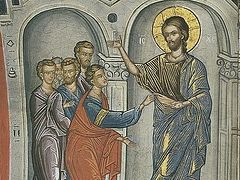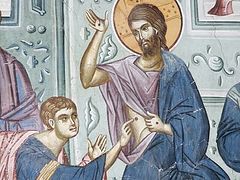 Dionysius. The Assurance of the Apostle Thomas. 1500 In the name of the Father, and of the Son, and of the Holy Spirit.
Dionysius. The Assurance of the Apostle Thomas. 1500 In the name of the Father, and of the Son, and of the Holy Spirit.
For many of us, the question of faith in the Resurrection of Christ seems to have been resolved long ago; we certainly believe that He is Risen from the dead. Year after year, we read about it, hear about it in sermons, and throughout Bright Week we proclaim it to each other in the Paschal greeting: “Christ is Risen!” And on the first Sunday after Bright Week, the Church draws our attention to the Gospel episode related to the Apostle Thomas’ “disbelief” in the Risen Christ. What is it done for? Is it just for us to discuss the faith of St. Thomas, or for something else that is revealed to us in this event? If Bright Week, uniting us in shared joy and triumph, emphasizes and highlights the Person of Christ and the event of His glorious Resurrection, then Thomas Sunday switches our attention to ourselves, in search of our personal living faith, which through the inner spiritual bond of each one of us with Christ already in this life must confirm the resurrection of our spirit and our personality.
A vivid and impressive Gospel episode, where the resurrection of the spirit and the personality and the transition of human consciousness from the temporary existence to eternal one takes place is the moment of the meeting of the Apostle Thomas with the Risen Savior. What significance can this Gospel event have for us today if we consider it only as a historical fact, concerning only the question of the faith of St. Thomas? And do we have the right to critically assess the “disbelief” of St. Thomas and the words he said: Except I shall see in His hands the print of the nails, and put my finger into the print of the nails, and thrust my hand into His side, I will not believe (Jn. 20:25)?
St. Thomas was the very disciple who suggested that the others die with Christ when He was going to travel to Bethany to raise Lazarus from the dead, despite the risk of being killed by the Jews. The Gospel of John contains the following words of the apostle Thomas: Then said Thomas, which is called Didymus, unto his fellow disciples, Let us also go, that we may die with Him (Jn. 11:16). These words show us how deep and sincere St. Thomas’s love for Christ was. We can only guess how deep the wound of his heart was from the separation from the Savior and from the awareness that He was no longer around. The words of those who had seen the Risen Lord were too weak to comfort the suffering and inconsolable heart of St. Thomas—it was still grieving the loss of its beloved Teacher. “If He is really alive, then I need to see Him and feel Him with all my senses; only then will my heart calm down,” St. Thomas mentally resists the evidence of the eyewitnesses who had seen the Risen Christ. The Apostle Thomas’ stubbornness is striking, and it can also be perceived as his disbelief. He doesn’t stubbornly resist just one person, but many who testified that at different times and in different places they had had contact with the Risen Christ. But here we would like to say a few words in defense of the apostle. His stubbornness, or “disbelief”, does not arise from a proud mind that resists a Divine event, but rather from a loving and suffering heart that cannot be consoled just by hearing good news from others. His heart boldly yearns for the fullness of communion with Christ so that he can touch the Savior just as he could do it before His death. The Apostle Thomas’ “disbelief” is a challenge to the Risen Christ, arising from a fervently loving heart, a thirst for communion with the One Whom he sacrificially loved, revealed in a daring inner longing to contemplate Him. His “disbelief”, expressed in the language of love, is not something negative and empty, but is an audacious departure from the elementary faith that cometh by hearing (Rom.10:17), which the Apostle Paul mentioned in his epistles, to the contemplative and spiritual one, which alone is able to fully unite you with Christ in living experience of communion with Him, thereby making you a partaker of the Divine nature.
Sometimes it seems to us that we believe in God deeply. But this faith may come from external awareness, from reading or hearing from others, rather than from our own real inner experience and unity with the Risen Lord. Without living communion with Christ, we are spiritually unprotected, trying to cling to the experience of those who testify that they saw God and conversed with Him. And we try to present this experience objectively, fitting it into the concepts that support our logic in order to build on the basis of this logic psychological self-sufficiency for ourselves, an “armor” that would protect us from fear and panic in the temptations and trials on the path of our faith and faithfulness to Christ.
Any assessment of the faith or “disbelief” of the Apostle Thomas on our part will sound too superficial, because he was experiencing a state that was both personal and supernatural. The “disbelief” and doubt of St. Thomas is not cold skepticism, akin to the doubt or unbelief of an atheist or someone who is indifferent to Christ. It is a doubt that anticipates a meeting; a doubt that anticipates absorption by Divine love, by an ineffable Divine revelation that changes and transforms human consciousness; a revelation of cosmic significance as it concerns the existential laws of the entire universe. After meeting with the Risen Christ, death for St. Thomas is longer be perceived as the final moment of being, but as the beginning of mankind’s further existence in a new, everlasting life—not only of our rational soul, but also of our restored body, which the apostle’s hands touched when he saw the Risen Savior in front of him.
It may seem that the positive points that were emphasized about the Apostle Thomas—his strong desire to see and touch Christ, as mentioned above—run counter to the Savior’s words addressed to the apostle: Blessed are they that have not seen, and yet have believed (Jn. 20:29). It looks as if the Lord puts faith above vision, lowering the spiritual bar for Christians, because it seems easier for us to simply believe than to strive to contemplate Christ. Why does Christ place faith above vision? Of course, He did not want to belittle the significance of sight and did not want to be hidden from people; but on the contrary, He had a desire to become as close to man as possible. In order to attain such union with Christ we were given the Church Sacraments, in which a person dies and is reborn, spiritually nourished and grows, uniting with Christ with his whole being, Till we all come in the unity of the faith, and of the knowledge of the Son of God, unto a perfect man, unto the measure of the stature of the fullness of Christ (Eph.4:13). According to the Apostle Paul, faith is connected with our knowledge of the Son of God, Christ, and our healing and salvation are attained in this way. Christ’s gentle reproach of St. Thomas the reproach of a man who applies the same methods of gaining knowledge in his communication with God that he uses in the material world. The true meaning of Christ’s words has to do with the way of knowing that St. Thomas chose in his ignorance; he longed to see the Lord in the same way he saw people and things of the world in everyday life around him—with the help of his mind and bodily sight. Jesus saith unto him, Thomas, because thou hast seen Me, thou hast believed: blessed are they that have not seen, and yet have believed (Jn. 20:29). The faith that Christ speaks of is also vision, but a different, supernatural vision, which must be revealed to a Christian through spiritual labors. According to St. Isaac the Syrian, “Faith is the doorway to the mysteries. What the eyes of the body are for physical objects, faith is for the hidden eyes of the soul.”
St. Thomas’s demand to see the Risen Christ’s nail marks and side, and the Savior’s words addressed to him, reveal to us in this Gospel episode a historic event that may be a prefiguration of our meeting with Christ in the sacrament of the Eucharist. Every time we approach the Chalice and receive Holy Communion, we surpass the Apostle Thomas in the degree of our closeness to God. He only touched Christ’s Body with His hand (Reach hither thy finger, and behold My hands; and reach hither thy hand, and thrust it into My side; Jn. 20:27), while we partake of the Most Pure Body of Christ; he contemplated Christ outside of himself, whereas we have the opportunity to contemplate Him within ourselves. But the question arises as tp whether we recognize Christ with our spiritual senses when we unite with Him, just as the Apostle Thomas recognized Him when he touched His wounds and exclaimed with rapture: My Lord and my God! (Jn. 20:28)?
Yet a little while, and the world seeth Me no more; but ye see Me: because I live, ye shall live also (Jn. 14:19), says the Savior in the Gospel of John. In these words, Christ draws a line between the external world, which rejected Him, and the world where, through the sacrament of faith, the Risen Christ is contemplated. This line is not drawn somewhere in the external environment, outside of ourselves, but right in our hearts, where grace and sin, light and darkness, faith and unbelief are present. And Christ is also there for those who seek Him. According to St. Simeon the New Theologian, “Those to whom the Risen Christ has revealed Himself, to them He has appeared spiritually, He has been shown to their spiritual eyes. When this happens to us through the Spirit, He raises us up from the dead and gives us life. He grants us to see Him, Who is immortal and indestructible,”1 and Whom the Apostle Thomas (who we commemorate today) longed to see with his bodily, not spiritual, sight. Through the prayers of St. Thomas, may the Lord enlighten us to move away from our enchantment with the visible world, and to seek the Risen Christ with a sober mind in the depths of our hearts. Amen. Christ is Risen!



